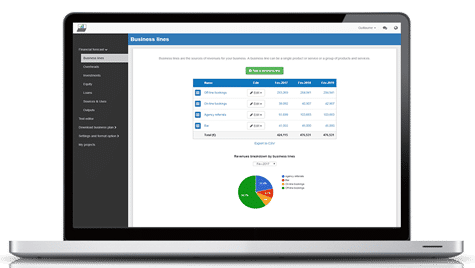How to create a financial forecast for a gas station?
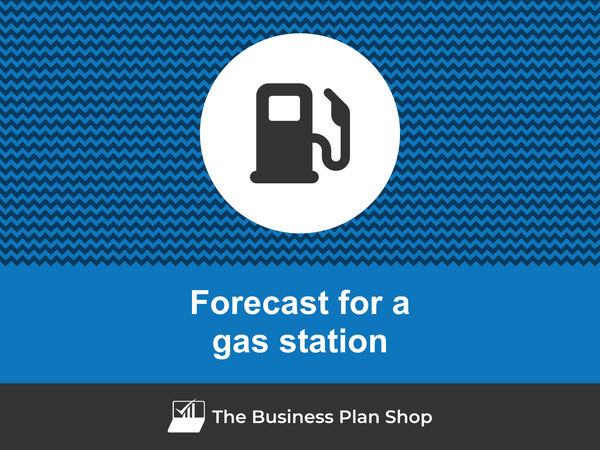
If you are serious about keeping visibility on your future cash flows, then you need to build and maintain a financial forecast for your gas station.
Putting together a gas station financial forecast may sound complex, but don’t worry, with the right tool, it’s easier than it looks, and The Business Plan Shop is here to guide you.
In this practical guide, we'll cover everything you need to know about building financial projections for your gas station.
We will start by looking at why they are key, what information is needed, what a forecast looks like once completed, and what solutions you can use to create yours.
Let's dive in!
Why create and maintain a financial forecast for a gas station?
Creating and maintaining an up-to-date financial forecast is the only way to steer the development of your gas station and ensure that it can be financially viable in the years to come.
A financial plan for a gas station enables you to look at your business in detail - from income to operating costs and investments - to evaluate its expected profitability and future cash flows.
This gives you the visibility needed to plan future investments and expansion with confidence.
And, when your trading environment gets tougher, having an up to date gas station forecast enables you to detect potential upcoming financing shortfalls in advance, enabling you to make adjustments or secure financing before you run out of cash.
It’s also important to remember that your gas station's financial forecast will be essential when looking for financing. You can be 100% certain that banks and investors will ask to see your numbers, so make sure they’re set out accurately and attractively.
Need a solid financial forecast?
The Business Plan Shop does the maths for you. Simply enter your revenues, costs and investments. Click save and our online tool builds a three-way forecast for you instantly.
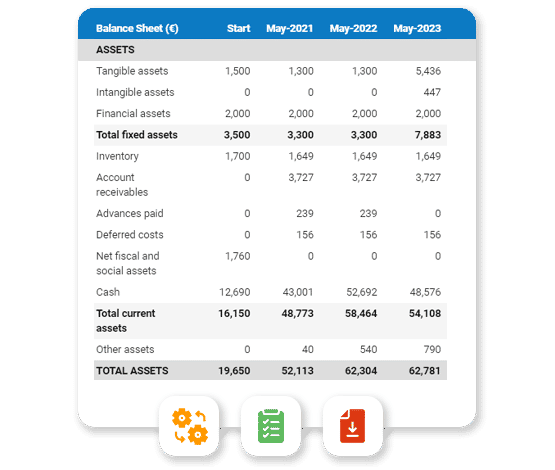
What information is used as input to build a gas station financial forecast?
A gas station's financial forecast needs to be built on the right foundation: your assumptions.
The data required to create your assumptions will depend on whether you are a new or existing gas station.
If you are creating (or updating) the forecast of an existing gas station, then your main inputs will be historical accounting data and operating metrics, and your team’s view on what to expect for the next three to five years.
If you are building financial projections for a new gas station startup, you will need to rely on market research to form your go-to-market strategy and derive your sales forecast.
For a new venture, you will also need an itemised list of resources needed for the gas station to operate, along with a list of equipment required to launch the venture (more on that below).
Now that you understand what is needed, let’s have a look at what elements will make up your gas station's financial forecast.
The sales forecast for a gas station
From experience, it usually makes sense to start your gas station's financial projection with the revenues forecast.
The inputs used to forecast your sales will include the historical trading data of your gas station (which can be used as a starting point for existing businesses) and the data collected in your market research (which both new ventures and existing businesses need to project their sales forward).
Your gas station's sales forecast can be broken down into two key estimates:
- The average price
- The number of monthly transactions
To assess these variables accurately, you will need to consider the following factors:
- Location: The location of your gas station can greatly impact the average price and number of monthly transactions. A gas station located on a busy highway or in a highly populated area may have higher prices and more transactions compared to one in a remote or less populated area.
- Competition: The presence of other gas stations in the vicinity can also affect your business's sales. If there are many other gas stations nearby, you may need to adjust your prices to stay competitive and attract customers.
- Fuel Prices: Fluctuations in fuel prices can directly impact the average price and number of monthly transactions at your gas station. When fuel prices are high, customers may opt to purchase less fuel or choose a different gas station with lower prices.
- Seasonal Demand: The demand for fuel can also vary depending on the season. During the summer months when more people are traveling, you may see an increase in transactions and prices. In contrast, during the winter months, when people tend to drive less, you may experience a decrease in transactions and prices.
- Economic Conditions: The overall state of the economy can also impact your gas station's sales. During times of economic downturn, people may choose to cut back on non-essential expenses, such as driving, which can lead to a decrease in transactions and prices at your gas station.
Once you have a sales forecast in place, the next step will be to work on your overhead budget. Let’s have a look at that now.
Need inspiration for your business plan?
The Business Plan Shop has dozens of business plan templates that you can use to get a clear idea of what a complete business plan looks like.

The operating expenses for a gas station
Once you know what level of sales you can expect, you can start budgeting the expenses required to operate your gas station on a daily basis.
Expenses normally vary based on how much revenue you anticipate (which is why, from experience, it is always better to start your forecast with the topline projection), and where your business is based.
Operating expenses for a gas station will include some of the following items:
- Staff Costs: This includes wages and benefits for all employees, including cashiers, mechanics, and attendants.
- Accountancy Fees: You will need to hire an accountant to handle your financial records, taxes, and other financial matters.
- Insurance Costs: It is important to have insurance for your gas station to protect against any potential accidents or damages.
- Software Licences: To keep track of inventory, sales, and other important data, you will need to purchase software licenses for your gas station.
- Banking Fees: Every time you process a credit or debit card transaction, there will be a fee charged by your bank.
- Rent/Mortgage: If you do not own the property where your gas station is located, you will have to pay rent or a mortgage.
- Utilities: This includes electricity, water, and gas for your gas pumps, store, and other facilities.
- Maintenance and Repairs: Regular maintenance and unexpected repairs for your gas pumps, equipment, and building will be necessary.
- Marketing and Advertising: To attract customers, you may need to invest in marketing and advertising efforts.
- Supplies: You will need to purchase supplies such as gasoline, oil, and other products to keep your gas station running.
- Taxes and Fees: As a business owner, you will be responsible for paying various taxes and fees, such as property taxes and business license fees.
- Security: To ensure the safety of your employees and customers, you may need to invest in security measures such as cameras and alarms.
- Training and Development: It is important to continuously train and develop your employees to provide excellent customer service and stay up-to-date on industry standards.
- Credit Card Processing Fees: In addition to banking fees, you will also incur fees for processing credit and debit card transactions.
- Waste Disposal: You will need to properly dispose of any hazardous materials used at your gas station, which may incur additional costs.
This list will need to be tailored to the specificities of your gas station, but should offer a good starting point for your budget.
What investments are needed to start or grow a gas station?
Your gas station financial forecast will also need to include the capital expenditures (aka investments in plain English) and initial working capital items required for the creation or development of your business.
For a gas station, these could include:
- Gas Pumps: These are the most essential fixed assets for a gas station. You will need to invest in high-quality pumps that can efficiently and accurately dispense fuel to your customers. These pumps should also be equipped with safety features to prevent accidents and comply with regulations.
- Underground Storage Tanks: These tanks are where you store the fuel for your gas station. It is important to invest in durable and leak-proof tanks to avoid any environmental hazards and costly clean-up expenses. You may also need to regularly monitor and maintain these tanks to ensure they are in good condition.
- Point of Sale System: This is the system that allows you to track sales, manage inventory, and process payments. Investing in a reliable and user-friendly point of sale system will not only streamline your operations but also provide valuable data for your financial forecasting and decision-making.
- Canopy and Roofing: The canopy is an important feature of a gas station as it provides shelter for customers while they pump gas. It also serves as a prominent branding opportunity for your business. Make sure to invest in a durable and visually appealing canopy and roofing that can withstand harsh weather conditions.
- Lighting and Signage: Proper lighting and signage are crucial for the safety and visibility of your gas station. Invest in energy-efficient and bright lighting to ensure your customers can easily see and navigate your station. Additionally, eye-catching and well-maintained signage can attract more customers and enhance your brand image.
Again, this list will need to be adjusted according to the size and ambitions of your gas station.
Need a convincing business plan?
The Business Plan Shop makes it easy to create a financial forecast to assess the potential profitability of your projects, and write a business plan that’ll wow investors.
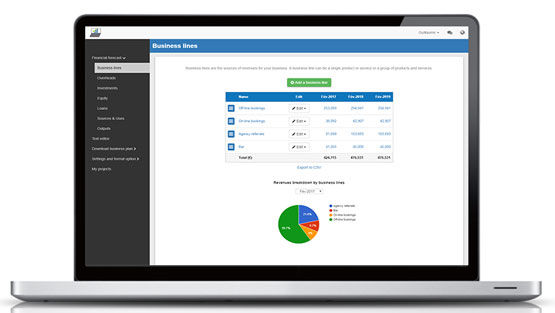
The financing plan of your gas station
The next step in the creation of your financial forecast for your gas station is to think about how you might finance your business.
You will have to assess how much capital will come from shareholders (equity) and how much can be secured through banks.
Bank loans will have to be modelled so that you can separate the interest expenses from the repayments of principal, and include all this data in your forecast.
Issuing share capital and obtaining a bank loan are two of the most common ways that entrepreneurs finance their businesses.
What tables compose the financial plan for a gas station?
Now let's have a look at the main output tables of your gas station's financial forecast.
The forecasted profit & loss statement
The profit & loss forecast gives you a clear picture of your business’ expected growth over the first three to five years, and whether it’s likely to be profitable or not.

A healthy gas station's P&L statement should show:
- Sales growing at (minimum) or above (better) inflation
- Stable (minimum) or expanding (better) profit margins
- A healthy level of net profitability
This will of course depend on the stage of your business: numbers for an established gas station will look different than for a startup.
The projected balance sheet
Your gas station's projected balance sheet provides a snapshot of your business’s financial position at year-end.
It is composed of three types of elements: assets, liabilities and equity:
- Assets: represent what the business possesses including cash, equipment, and accounts receivable (money owed by clients).
- Liabilities: represent funds advanced to the business by lenders and other creditors. They include accounts payable (money owed to suppliers), taxes payable and loans from banks and financial institutions.
- Equity: is the combination of what has been invested by the business owners and the cumulative profits and losses generated by the business to date (which are called retained earnings). Equity is a proxy for the value of the owner's stake in the business.
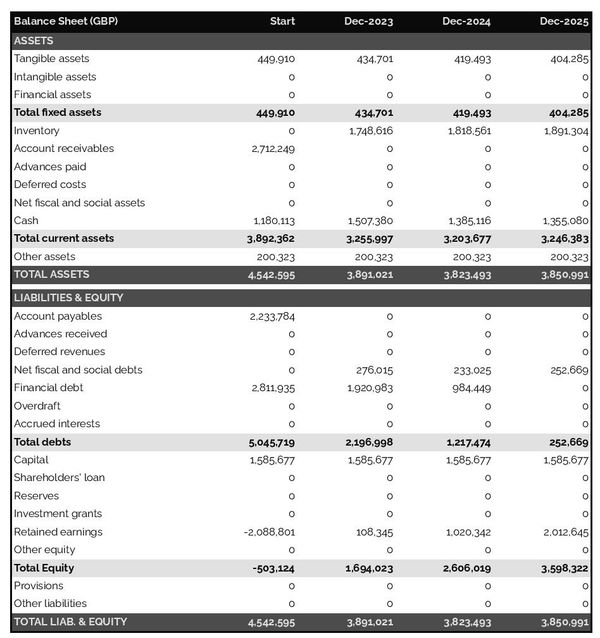
The cash flow projection
The cash flow forecast of your gas station will show how much cash the business is expected to generate or consume over the next three to five years.

There are multiple ways of presenting a cash flow forecast but from experience, it is better to organise it by nature in order to clearly show these elements:
- Operating cash flow: how much cash is generated by the gas station's operations
- Investing cash flow: what is the business investing to expand or maintain its equipment
- Financing cash flow: is the business raising additional funds or repaying financiers (debt repayment, dividends)
Your cash flow forecast is the most important element of your overall financial projection and that’s where you should focus your attention to ensure that your gas station is adequately funded.
Note: if you are preparing a financial forecast in order to try to secure funding, you will need to include both a yearly and monthly cash flow forecast in your gas station's financial plan.
Need a solid financial forecast?
The Business Plan Shop does the maths for you. Simply enter your revenues, costs and investments. Click save and our online tool builds a three-way forecast for you instantly.

Which tool should you use to create your gas station's financial forecast?
Using the right tool or solution will make the creation of your gas station's financial forecast much easier than it sounds. Let’s explore the main options.
Using online financial forecasting software to build your gas station's projections
The modern and easiest way is to use an online financial forecasting tool such as the one we offer at The Business Plan Shop.
There are several advantages to using specialised software:
- You can easily create your financial forecast by letting the software take care of the financial calculations for you without errors
- You have access to complete financial forecast templates
- You get a complete financial forecast ready to be sent to your bank or investors
- You can easily track your actual financial performance against your financial forecast, and recalibrate your forecast as the year goes by
- You can create scenarios to stress test your forecast's main assumptions
- You can easily update your forecast as time goes by to maintain visibility on future cash flows
- You have a friendly support team on standby to assist you when you are stuck
- It’s cost-efficient and much cheaper than using an accountant or consultant (see below)
If you are interested in this type of solution, you can try our projection software for free by signing up here.
Calling in a financial consultant or chartered accountant
Outsourcing the creation of your gas station financial forecast is another possible solution.
This will cost more than using software as you can expect as your price will have to cover the accountant’s time, software cost, and profit margin.
Price can vary greatly based on the complexity of your business. For a small business, from experience, a simple three-year financial forecast (including a balance sheet, income statement, and cash flow statement) will start at around £700 or $1,000.
Bear in mind that this is for forecasts produced at a single point in time, updating or tracking your forecast against actuals will cost extra.
If you decide to outsource your forecasting:
- Make sure the professional has direct experience in your industry and is able to challenge your assumptions constructively.
- Steer away from consultants using sectorial ratios to build their client’s financial forecasts (these projections are worthless for a small business).
Why not use a spreadsheet such as Excel or Google Sheets to build your gas station's financial forecast?
Creating an accurate and error-free gas station financial forecast on Excel (or any spreadsheet) is very technical and requires both a strong grasp of accounting principles and solid skills in financial modelling.
Most entrepreneurs lack the expertise required to create an accurate financial forecast using spreadsheet software like Excel or Google Sheets. As a result, it is unlikely anyone will trust your numbers.
The second reason is that it is inefficient. Building forecasts on spreadsheets was the only option in the 1990s and early 2000s, nowadays technology has advanced and software can do it much faster and much more accurately.
This is why professional forecasters all use software. With the rise of AI, software is also becoming smarter at helping us detect mistakes in our forecasts and helping us analyse the numbers to make better decisions.
Finally, like everything with spreadsheets, tracking actuals vs. forecasts and updating your forecast as the year progresses is manual, tedious, error-prone, and time-consuming. Whereas financial forecasting software like The Business Plan Shop is built for this.
Need a convincing business plan?
The Business Plan Shop makes it easy to create a financial forecast to assess the potential profitability of your projects, and write a business plan that’ll wow investors.

Use our financial projection templates for inspiration
The Business Plan Shop has dozens of financial forecast templates available.
Our examples contain a complete business plan with a financial forecast and a written presentation of the company, the team, the strategy, and the medium-term objectives.
Whether you are just starting out or already have your own gas station, looking at our financial forecast template is a good way to:
- Understand what a complete business plan should look like
- Understand how you should model financial items for your gas station
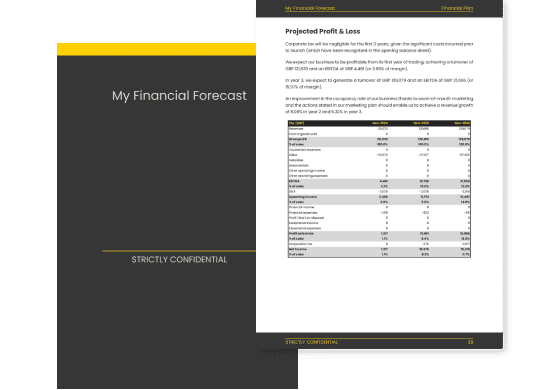
Takeaways
- A financial forecast shows expected growth, profitability, and cash generation metrics for your gas station.
- Tracking actuals vs. forecast and having an up-to-date financial forecast is key to maintaining visibility on your future cash flows.
- Using financial forecasting software is the modern way of creating and maintaining financial projections.
We hope that this guide helped you gain a clearer perspective on the steps needed to create the financial forecast for a gas station. Don't hesitate to contact us if you have any questions!
Need inspiration for your business plan?
The Business Plan Shop has dozens of business plan templates that you can use to get a clear idea of what a complete business plan looks like.

Also on The Business Plan Shop
Know someone who runs a gas station? Share our business guide with them!

